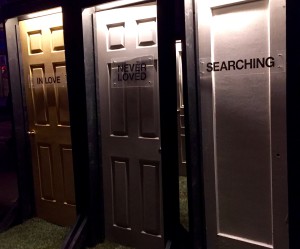What door do I walk through, and why do I choose it?

Those were the questions examined at an ArtBoston exhibit that I, and many others walked through. Doors opened and shut as we went, and a computer kept track of the choices made, tallying them up, and creating graphs depicting the spectrum of choices made.
Looking at the graphs while realizing they’re clearly anecdotal and not scientific, I wondered about their significance. Almost tied were the people who went through the “In Love”, and “Searching” doors; only 12% passed through the “Never Loved” door. I wondered if this spoke to anything about people’s views and experiences in marriage and divorce?

I began to think about the psychologist John Bowlby and his attachment theory research, in which he categorized kinds of attachment people had for others: “secure”, which he concluded occurred when people had a positive and loving relationship with their primary caregiver, “avoidant”, which resulted from having felt rejected and unloved by one’s primary caregiver, and “resistant”, which resulted when someone had been cared for by an angry and confused caregiver. If nothing else, I saw a striking closeness between the numbers of ArtBoston door opening adults who chose “Never Loved” (12%) and Bowlby’s “resistant” population (15%). Arguably, the “Never Loved” identifiers were not in relationships, while the remainder of folks were, had been, and/or hoped one day to be. It would stand to reason then that most people going through a divorce are looking, or hoping to love again.

The “I Can Change”, “I Can’t Change”, and “Nothing Changes” doors, also fascinated me.


A huge margin of people believed they could change. A tiny number believed they couldn’t change, and the remaining people passively believed that “nothing changes”. As change is a hallmark of divorce and restructured families, seeing that difficult time as a chance for positive growth could harness hope and give families more wide-ranging and positive outlooks.
The “past”, “present” and “future” doors were also instructive. By a landslide, most folks passing through the doors chose either present or future, while only 15% chose past. Most people want to move forward, and almost as many are present-focused. The tasks then seem to be to help people who are present-minded think about and move toward the future, a difficult task when their present needs feel overwhelming and/or unmet; help people who are future-minded address real and present concerns before jumping full stop into the future; and help people who are past-focused, frame and preserve their history so that they can regroup, address their present needs, and create and embrace their futures.
If the ArtBoston exhibit is an indicator, most divorcing people, and their children, believe they can change, and want to be in future relationships.
Helping people contextualize their histories, grapple with the present, and creatively craft hopeful, grounded, realistic future restructurings of their families is our extraordinary privilege.



